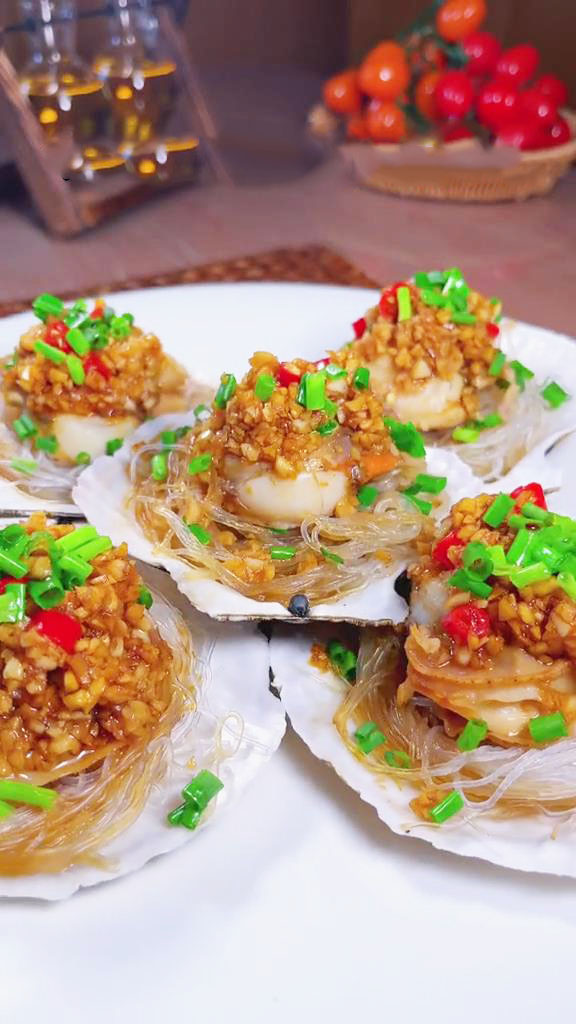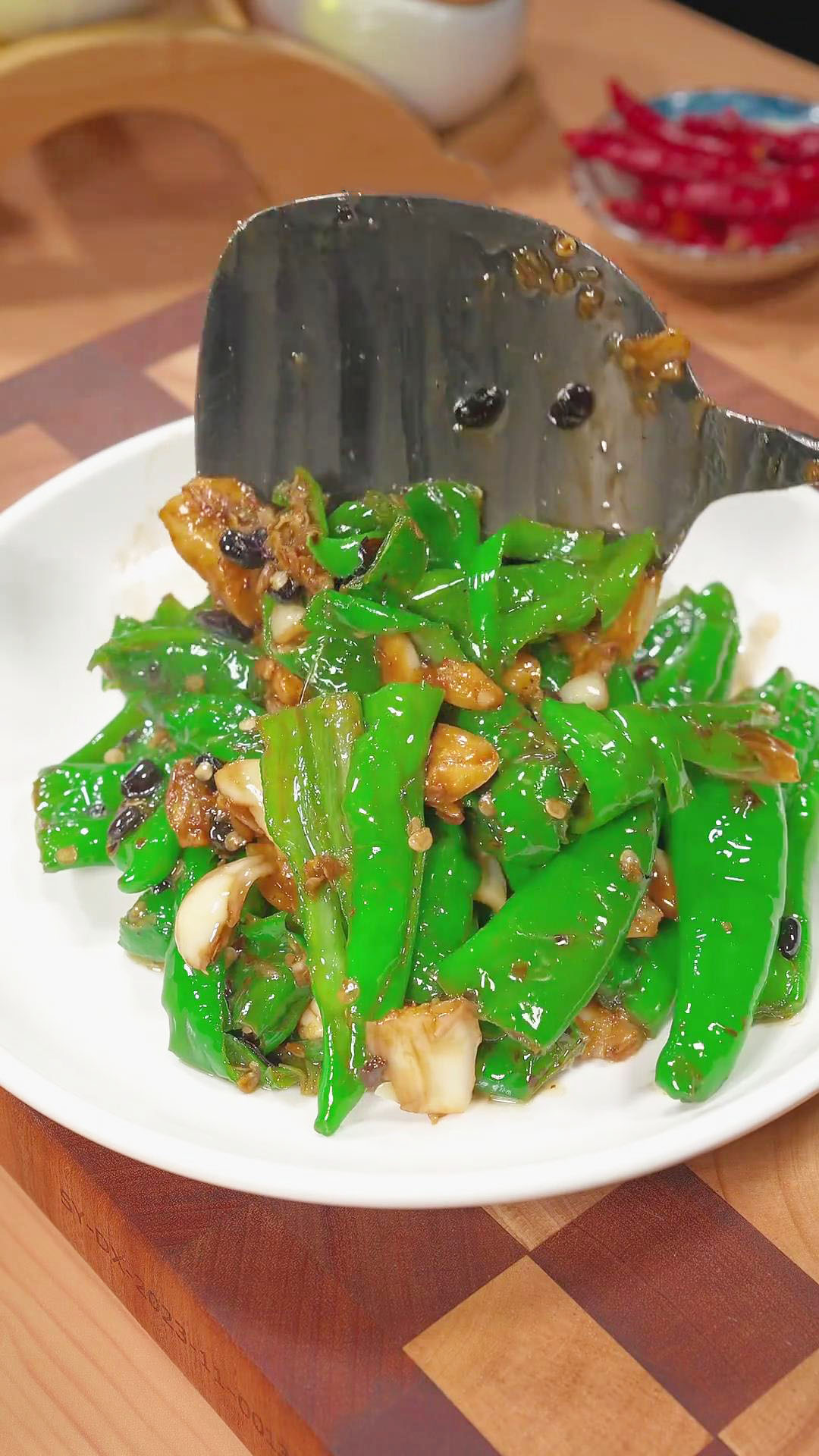Calling all chili lovers! Here‘s a full version of how to make Chinese chili oil using hot oil with several spices and aromatics. It may be a long list of ingredients, but trust me—it is the most flavorful, fragrant, and mouthwatering chili oil you will ever have.
All About Chinese Chili Oil
Chinese chili oil just makes any dish even better with its fiery, earthy, and smoky taste. It is not just chili in the jar, but several spices and aromatics that blend harmoniously. You get the nuttiness of the sesame seeds, a hint of mustiness of the white pepper, and a bit of tang with white vinegar.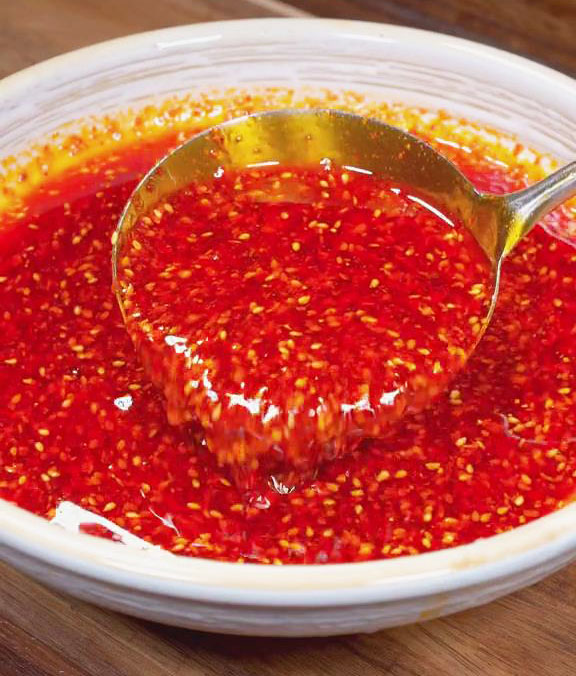
The oil is not merely heated oil, but an aromatics-infused oil. The aromatics this recipe uses are green onions, ginger, garlic, red onions, and fresh coriander. Finally, after frying the aromatics for a couple of minutes, the extra spices added are Sichuan peppercorns, star anise, cinnamon stick, bay leaves, and a touch of baijiu.
So, you also get to enjoy the tingling, numbing sensation of Sichuan peppercorns, the licorice-like taste of star anise, and the woodiness of cinnamon, among other things. I know you get Chinese chili oil in grocery stores, but nothing beats a homemade version made from quality ingredients without preservatives or harmful chemicals.
Are you the type who likes things short and simple? Then follow my Szechuan dumpling recipe where I whipped up chili oil using only 3 ingredients: chili flakes, white sesame seeds, and hot oil.
Want more recipes like Chinese chili oil? Here are my top recipes for sauces and condiments:
- Chinese Yu Xiang Sauce
- Chinese Five Spice Powder
- Salt And Pepper Seasoning Using 6 Spices
- Chinese Black Bean Sauce
- Fermented Black Beans
- Fried Shallots In Oil
- Crispy Fried Garlic
- Thai Roasted Chili Paste
- Sweet Soy Sauce
- Soy Sauce Vinegar Recipe (Dumpling Sauce)
- 6 Hot Pot Dipping Sauces
- Four Dumpling Sauce
How To Use Chinese Chili Oil
Once you have a batch of Chinese chili oil, you can use it for various dishes, from wontons to salads and noodles. Use it as a topping, add-on flavoring ingredient, or dipping sauce. Just don’t go crazy with it though or else you will run out pretty fast and cook another batch.
Here are some recipes where Chinese chili oil would be a great pairing:
- Sichuan Wontons In Chili Oil (Spicy Chao Shou)
- Green Papaya Salad With Oil-Free Dressing
- Boiled Okra With Spicy Savory Sauce
- Kung Pao Shrimp
- Century Egg Tofu
- Chinese Poached Chicken (With 2 Dipping Sauces)
- Chewy And Spicy Potato Noodles
- Spicy Handmade Noodles (Biang Biang Noodles)
- Spiral Cucumber Salad
- Chicken Bao Bun
- Beef Bao Bun
- Cheung Fun (Steamed Rice Noodle Rolls)
- Scallion Oil Noodles (葱油拌面)
A Breakdown Of The Ingredients
Here’s a detailed breakdown of the ingredients and how each is essential for the recipe. If you are looking for alternatives, I share below some of my top tips and recommendations.
- Chili flakes: The main ingredient is chili flakes. It makes the sauce spicy, sweet, and smoky. The closest alternatives to chili flakes are red pepper flakes, chili powder, and blended dried red chili peppers.
- Ground chili: In addition to chili flakes, you will need ground chili. This provides a more powerful kick of heat. If you prefer a subtle heat, better to omit this or lessen the amount.
- White sesame seeds: White sesame seeds are great for their nutty flavor and crunchy texture. It is perfectly fine to replace this with black sesame seeds. However, black sesame seeds tend to be more potent than white.
- Salt: Salt just boosts the sauce by bringing out the flavors of the seasonings. Use any type of salt, such as sea salt, pink salt, and kosher salt.
- White pepper powder: White pepper is preferable for its unique musty, earthy taste and subtle heat. If you replace it with black pepper powder, the taste leans more woody, piney, and hot.
- White vinegar: A bit of white vinegar adds a hint of tanginess and enhances the color of the spices. If you want Chinese vinegar, use Chinese black vinegar, also known as Chinkiang vinegar or Zhenjiang vinegar. It is also tangy but with a fruity and slightly sweet taste. Aside from taste, white vinegar helps preserve the sauce.
- Edible oil: Any edible cooking oil will do for this recipe. Use olive, avocado, sesame, or safflower oil for a healthier option. If you want a neutral taste, go for peanut, soybean, or vegetable oil.
- Hot oil: It is better to use neutral-tasting oil as your oil base, such as peanut, soybean, or vegetable oil. This needs to be heated to about 160 degrees Celsius until it starts to bubble and sizzle. It is also recommended to use oil with a high smoke point to reduce the amount of oil oxidized and to withstand heat longer. Oil with a high smoke point are avocado, peanut, canola, and corn oil.
- Green onion: The oil is infused with a bunch of green onions or scallions. This lends a pungent, slightly sweet, oniony taste. You can swap green onions for spring onions or chives. In terms of taste, spring onions are sweet and pungent, while chives are light with a hint of garlic taste.
- Ginger: Ginger makes the oil peppery and warm with notes of citrus. If needed, you can replace fresh ginger with ground ginger to still have the taste of ginger. Use 1/4 to 1/2 tsp ground ginger for every 1 tbsp of fresh ginger.
- Garlic: The oil gets its garlicky taste with garlic cloves. It imparts a nutty, earthy, and pungent taste. If you don’t have garlic but want the garlicky flavors, you can substitute 1 clove of garlic with 1/8 tsp of garlic powder or 1/4 tsp of granulated garlic.
- Red onion: I prefer red onion for its subtle sweetness and mild taste. You can also use shallots, white onions, or yellow onions.
- Coriander: Adding fresh coriander imparts a tart, lemon-like taste. Alternatively, this can be omitted or simply replaced with other chopped herbs, such as dill, parsley, mint, cilantro, or basil.
- Sichuan peppercorn: I love Sichuan peppercorn for its unique tingling and numbing sensation. In terms of flavor profile, it is slightly floral and lemon-like. You can replace it with regular black pepper or white pepper powder, but the taste won’t be the same. So, I highly recommend getting this in the spice section of a local grocery store or online market like Amazon.
- Star anise: Star aniseis a star-shaped spice known for its warm, woody, and licorice-like taste. You can replace star anise with anise seeds, Chinese five spice, allspice, fennel seeds, and cloves. I share in my guide, The Best Star Anise Substitute, how to substitute star anise with the right amount.
- Cinnamon sticks: I added about two cinnamon sticks to lend a woody, spicy, and citrusy taste. If you don’t have cinnamon sticks, try using Chinese five-spice powder, nutmeg, Allspice, or cloves.
- Bay leaves: A few bay leaves give the sauce a hint of thyme and oregano flavors. The closest alternatives for bay leaves are dried oregano, thyme, and basil.
- Baijiu (白酒): Last but not least, a small amount of baijiu is added at the end to give the sauce a more in-depth flavor and aroma. Moreover, it also helps preserve the sauce longer. This is also known as shaojiu and you can buy it in Asian grocery stores or on Amazon. It is going to be a worthy purchase since you can use baijiu for various recipes, such as Chinese sausages, mooncakes with egg yolk and lotus paste, and Chinese cured pork belly (lap yuk/Chinese bacon).
Ingredients And Kitchenware
You will need a heat-resistant bowl to mix the seasonings with hot oil and a large pot and scooper to heat oil with the aromatics. Moreover, make sure to have a clean glass jar with a lid for sauces. Glass is way better than plastic since it is impermeable and non-porous, preserving the flavor and aroma more effectively.
For the ingredients, here’s what you need and adjust to taste:
- 1 tbsp of chili flakes
- 1 tbsp of ground chili
- 1 tbsp of white sesame seeds
- 1 tsp of salt
- 1 tsp of white pepper powder
- 1 tbsp of white vinegar
- 1 tbsp of edible oil
- 1 bowl of neutral oil (enough to cook the aromatics)
- 50g of green onion
- 15g of ginger slices
- 6 cloves of garlic (peeled)
- 80g of chopped red onions
- 50g of fresh coriander
- 3g of Sichuan peppercorns
- 5g of star anise
- 6g of cinnamon stick
- 4bay leaves
- 1 tsp of high-quality baijiu
Steps To Make Chinese Chili Oil
In a nutshell, the main steps are to mix the spices in a bowl, heat the aromatics with oil, and pour the hot oil over the spices in the bowl. You can finish the recipe in less than 15 minutes! Watch my short tutorial video on Instagram or TikTok and don’t forget to give it a heart.
Are you done making this Chinese chili oil recipe? How did you use it for your dishes? Let us know by sharing it in the comments section and tagging me @kitchenmisadventures.
- In a large heat-resistant bowl, mix chili flakes, ground chili, white sesame seeds, salt, and white pepper.
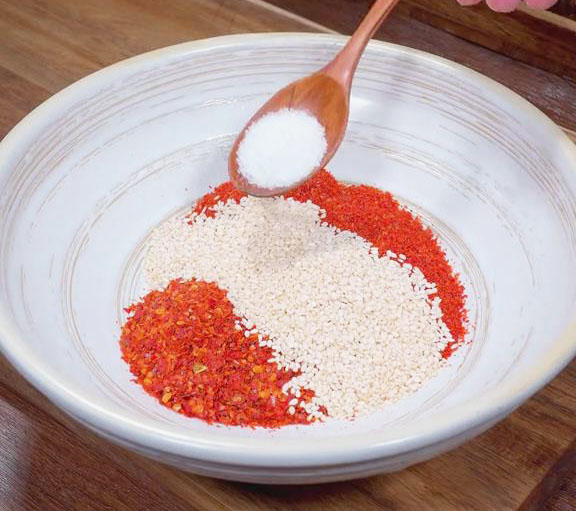
- Then, add white vinegar and edible oil. Give it a good stir and set aside.
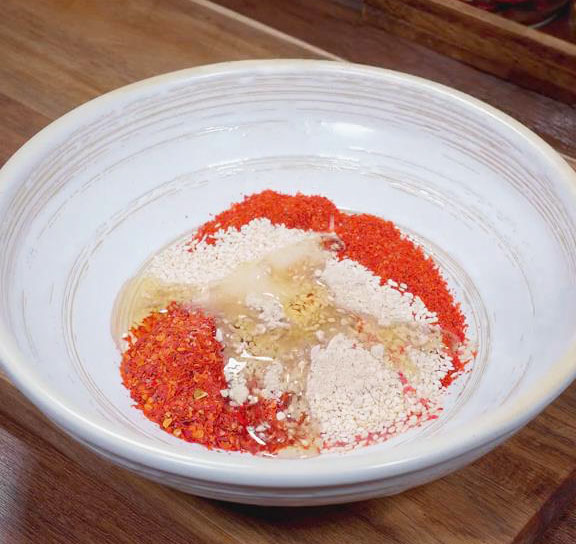
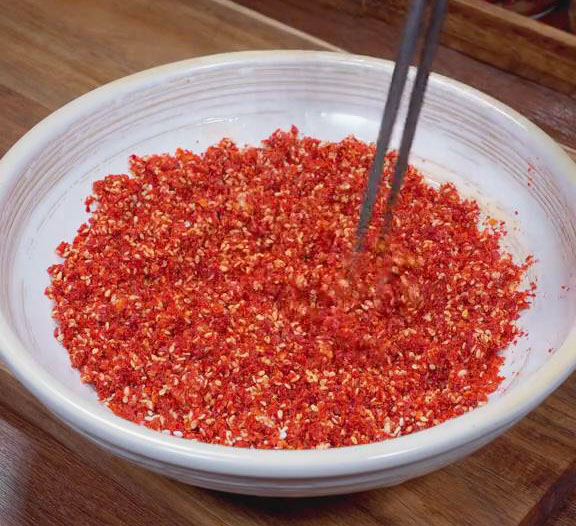
- In a large pot, heat up neutral oil until it’s about 160°C.
- Once hot, toss in some green onions, ginger slices, peeled garlic, chopped red onions, and fresh coriander. Let them sizzle for 2 minutes.
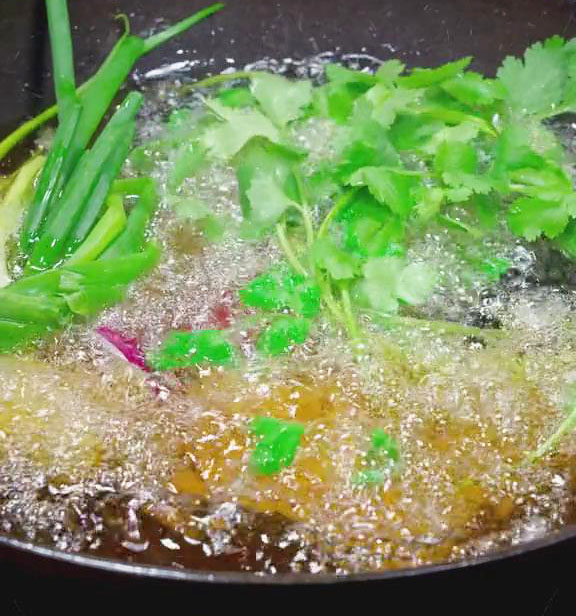
- After frying for about 2 minutes, add Sichuan peppercorns, star anise, cinnamon stick, and bay leaves and continue frying until fragrant. Once done, take out the aromatics, leaving you with clean oil.

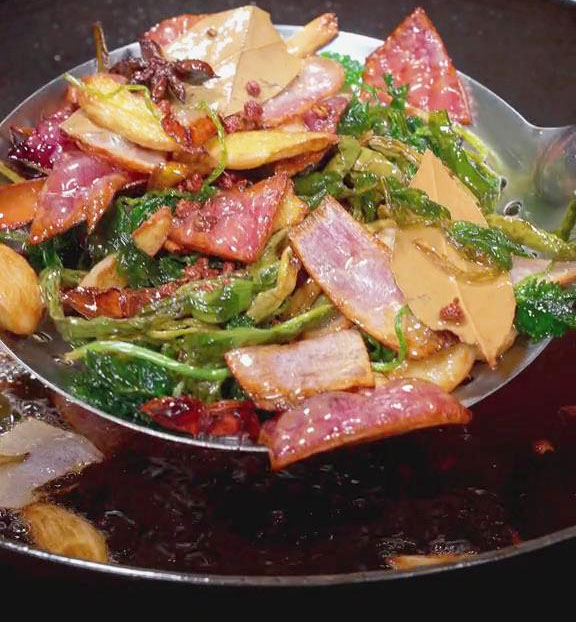
- Slowly pour 1 scoop of hot oil into the bowl of seasoning and mix well. Repeat this step 2 more times, giving you a total of 3 scoops. This will ensure that the peppers are spicy and not dry.
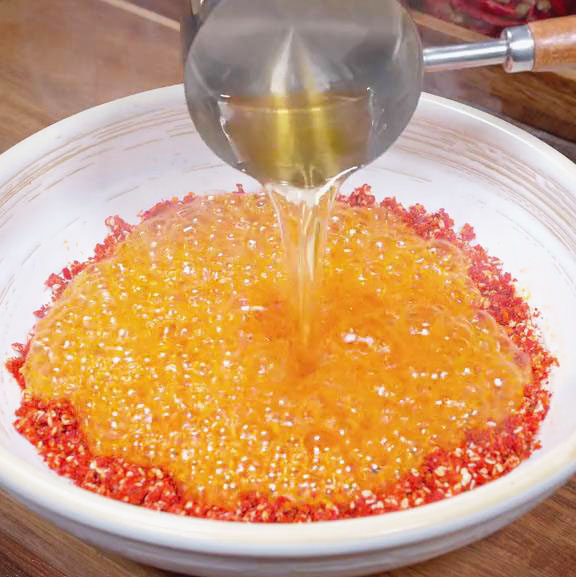
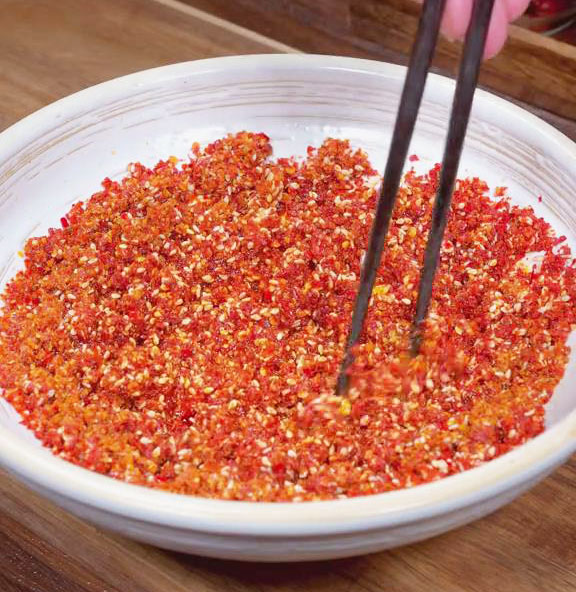
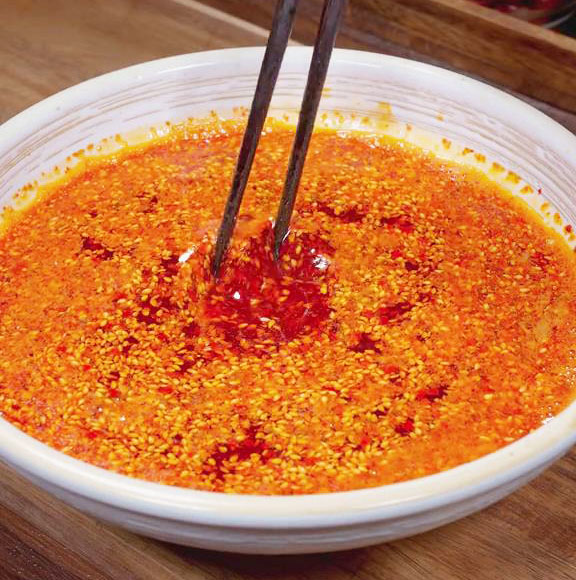
- For the finishing touch, add a little baijiu.
- Let it cool a bit before transferring the chili oil to a spice glass jar with a lid.
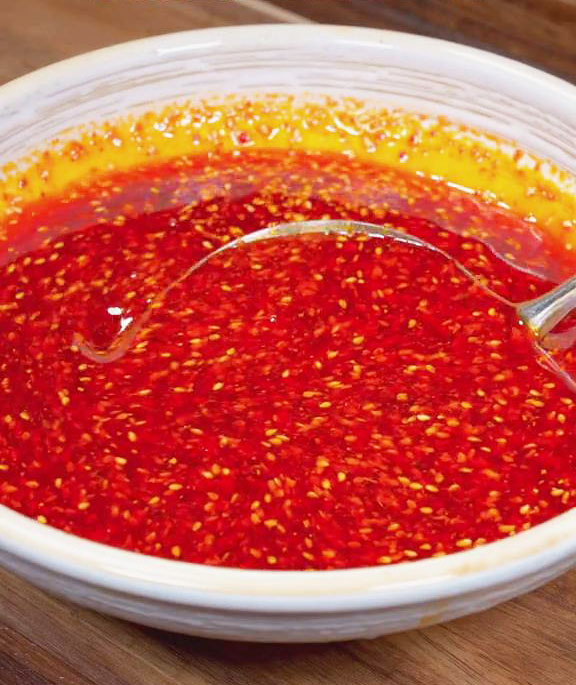
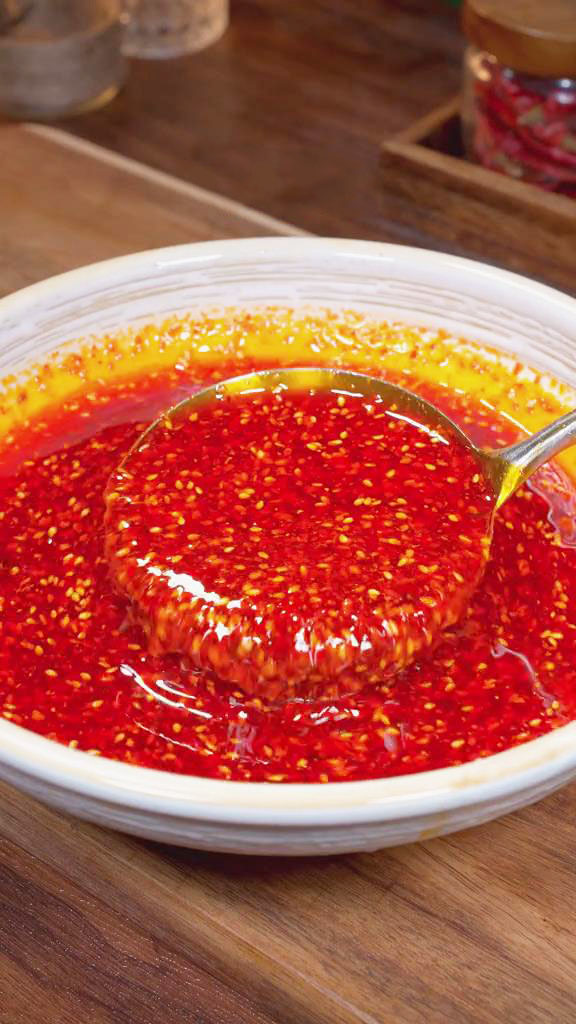
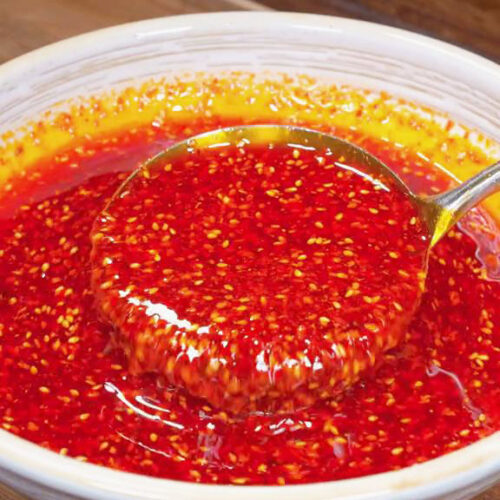
How To Make Chinese Chili Oil
Calling all chili lovers! Here's a full version of how to make Chinese chili oil using hot oil with several spices and aromatics. It may be a long list of ingredients, but trust me—it is the most flavorful, fragrant, and mouthwatering chili oil you will ever have.Ingredients
- 1 tbsp of chili flakes
- 1 tbsp of ground chili
- 1 tbsp of white sesame seeds
- 1 tsp of salt
- 1 tsp of white pepper powder
- 1 tbsp of white vinegar
- 1 tbsp of edible oil
- 1 bowl of neutral oil enough to cook the aromatics
- 50 g of green onion
- 15 g of ginger slices
- 6 cloves of garlic peeled
- 80 g of chopped red onions
- 50 g of fresh coriander
- 3 g of Sichuan peppercorns
- 5 g of star anise
- 6 g of cinnamon stick
- 4 bay leaves
- 1 tsp of high-quality baijiu
Instructions
- In a large heat-resistant bowl, mix chili flakes, ground chili, white sesame seeds, salt, and white pepper.
- Then, add white vinegar and edible oil. Give it a good stir and set aside.
- In a large pot, heat up neutral oil until it's about 160°C.
- Once hot, toss in some green onions, ginger slices, peeled garlic, chopped red onions, and fresh coriander. Let them sizzle for 2 minutes.
- After frying for about 2 minutes, add Sichuan peppercorns, star anise, cinnamon stick, and bay leaves and continue frying until fragrant. Once done, take out the aromatics, leaving you with clean oil.
- Slowly pour 1 scoop of hot oil into the bowl of seasoning and mix well. Repeat this step 2 more times, giving you a total of 3 scoops. This will ensure that the peppers are spicy and not dry.
- For the finishing touch, add a little baijiu.
- Let it cool a bit before transferring the chili oil to a spice glass jar with a lid.
Video
Nutrition
Calories: 364kcalCarbohydrates: 40gProtein: 9gFat: 23gSaturated Fat: 2gPolyunsaturated Fat: 8gMonounsaturated Fat: 12gTrans Fat: 0.1gSodium: 2630mgPotassium: 1101mgFiber: 16gSugar: 7gVitamin A: 8678IUVitamin C: 37mgCalcium: 357mgIron: 9mgTried this recipe?Let us know how it was!

